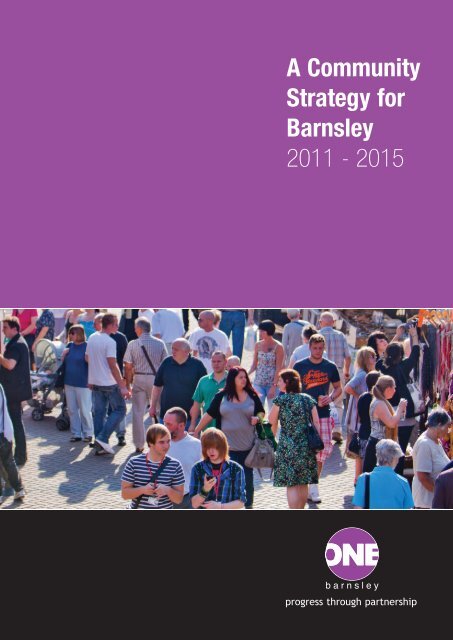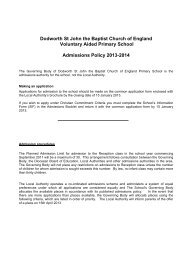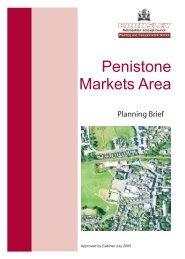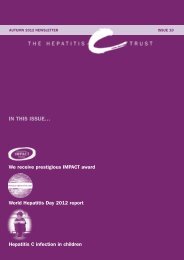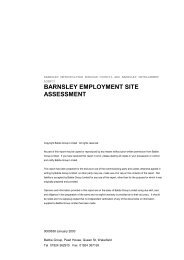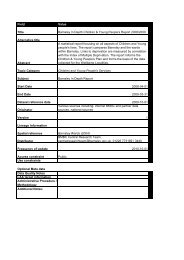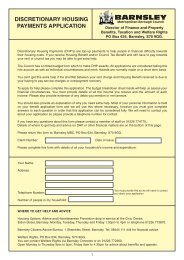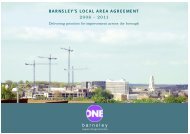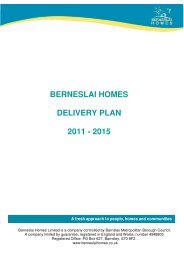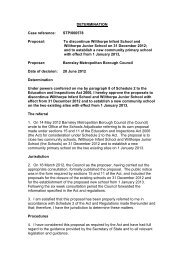A Community Strategy for Barnsley 2011 - 2015 - Barnsley Council ...
A Community Strategy for Barnsley 2011 - 2015 - Barnsley Council ...
A Community Strategy for Barnsley 2011 - 2015 - Barnsley Council ...
You also want an ePaper? Increase the reach of your titles
YUMPU automatically turns print PDFs into web optimized ePapers that Google loves.
A <strong>Community</strong><br />
<strong>Strategy</strong> <strong>for</strong><br />
<strong>Barnsley</strong><br />
<strong>2011</strong> - <strong>2015</strong><br />
progress through partnership
Contents<br />
Contents<br />
Introduction 3<br />
Background 4<br />
The New <strong>Community</strong> <strong>Strategy</strong> 5<br />
The principles 5<br />
The vision 5<br />
The priorities and catalysts <strong>for</strong> change 5<br />
Ensuring the wellbeing of <strong>Barnsley</strong> 6<br />
A new <strong>Strategy</strong> <strong>for</strong> <strong>Barnsley</strong> 6<br />
The Priorities and Catalysts <strong>for</strong> Change -<br />
A closer look 7<br />
Growing a 21st Century Economy 7<br />
The context 7<br />
Why this priority is important <strong>for</strong> <strong>Barnsley</strong> 7<br />
What we want to achieve 8<br />
What success will look like 8<br />
Growing a 21st century relationship between<br />
citizens, voluntary/community sector and<br />
public sector agencies and organisations 9<br />
The context 9<br />
Why this priority is important <strong>for</strong> <strong>Barnsley</strong> 9<br />
What we want to achieve 10<br />
What success will looklike 11<br />
A low carbon future 11<br />
The context 11<br />
Why this is important <strong>for</strong> <strong>Barnsley</strong> 12<br />
What we want to achieve 12<br />
What success will look like 12<br />
Digital <strong>Barnsley</strong> 13<br />
Context 13<br />
Why this is important <strong>for</strong> <strong>Barnsley</strong> 13<br />
What we want to achieve 14<br />
What success will look like 14<br />
Equality and Fairness 15<br />
<strong>Community</strong> <strong>Strategy</strong> -<br />
Delivery and Per<strong>for</strong>mance 16<br />
Summary 18<br />
Front cover photograph: Timm Cleasby<br />
2<br />
A <strong>Community</strong> <strong>Strategy</strong> <strong>for</strong> <strong>Barnsley</strong> <strong>2011</strong> - <strong>2015</strong>
Introduction<br />
Introduction<br />
The new <strong>Community</strong> <strong>Strategy</strong> <strong>for</strong> <strong>Barnsley</strong> <strong>2011</strong>-<strong>2015</strong> has been<br />
developed by ‘One <strong>Barnsley</strong>’ (<strong>Barnsley</strong>'s Local Strategic<br />
Partnership) in response to the ever changing financial and policy<br />
context we now find ourselves part of, and in which we will<br />
continue to work in partnership over the next 4 years.<br />
The new strategy builds on a history of strong partnership<br />
working in <strong>Barnsley</strong>. It also builds on the progress that One<br />
<strong>Barnsley</strong> has already made over a number of years towards<br />
achieving the long-term vision <strong>for</strong> the borough as "a successful,<br />
uniquely distinctive 21st century market town at the centre<br />
of a Borough that offers prosperity and a high quality of life<br />
<strong>for</strong> all."<br />
Photograph:Timm Cleasby<br />
Although there is no longer a statutory requirement to produce a<br />
Sustainable <strong>Community</strong> <strong>Strategy</strong>, all One <strong>Barnsley</strong> board members<br />
(shown below) and other partner organisations, remain committed<br />
to delivering the new <strong>Community</strong> <strong>Strategy</strong> <strong>for</strong> <strong>Barnsley</strong> over the<br />
next four years. They all agree that, against a backdrop of reduced<br />
resources and changing policy landscape, partnership working is<br />
even more important now than ever be<strong>for</strong>e.<br />
One <strong>Barnsley</strong> Board partners<br />
<strong>Barnsley</strong> Hospital NHS<br />
Foundation Trust<br />
South Yorkshire<br />
Fire and Rescue<br />
<strong>Barnsley</strong><br />
Metropolitan<br />
Borough <strong>Council</strong><br />
<strong>Barnsley</strong> and Rotherham<br />
Chamber<br />
of Commerce<br />
<strong>Barnsley</strong> <strong>Community</strong> and<br />
Voluntary Network<br />
Job Centre Plus<br />
<strong>Barnsley</strong> College<br />
South Yorkshire<br />
Police<br />
barnsley<br />
BOARD<br />
South & West Yorkshire<br />
Partnership<br />
Foundation Trust<br />
NHS <strong>Barnsley</strong><br />
Stagecoach<br />
University of Huddersfield<br />
<strong>Barnsley</strong> Campus<br />
3<br />
A <strong>Community</strong> <strong>Strategy</strong> <strong>for</strong> <strong>Barnsley</strong> <strong>2011</strong> - <strong>2015</strong>
Background<br />
Background<br />
The Sustainable <strong>Community</strong> <strong>Strategy</strong> (SCS) <strong>for</strong> <strong>Barnsley</strong> 2008-<br />
2020 was developed and agreed by One <strong>Barnsley</strong> in 2008, in<br />
line with the requirements of the Local Government and Public<br />
Involvement in Health Act 2007. The Local Area Agreement<br />
(2008-11) was the statutory 3 year delivery plan <strong>for</strong> the<br />
strategy, with the priorities, measures and targets agreed with<br />
partners and central government.<br />
<strong>Barnsley</strong>'s SCS 2008-2020 set out the strategic vision <strong>for</strong><br />
<strong>Barnsley</strong> as "A successful, uniquely distinctive 21st century<br />
market town at the centre of a borough that offers<br />
prosperity and a high quality of life <strong>for</strong> all." This vision was<br />
complemented by a commitment to 11 ambitions <strong>for</strong> the<br />
borough and set the context <strong>for</strong> the 11 outcomes within the<br />
Local Area Agreement.<br />
Significant work to achieve these outcomes has been<br />
progressed through One <strong>Barnsley</strong> over the past 3 years.<br />
Successes have included:<br />
• <strong>Barnsley</strong> is a safer place to live with a decrease in overall<br />
levels of crime and adult re-offending rates.<br />
• Improvements in education attainment at all key stages<br />
especially foundation and GCSE.<br />
• Above target provision of af<strong>for</strong>dable homes.<br />
• <strong>Barnsley</strong> is a more sustainable Borough with an increase in<br />
the recycling of household waste.<br />
It is accepted however, that the SCS was developed in a very<br />
different financial and policy context to that in which we find<br />
ourselves in <strong>2011</strong>.<br />
To better reflect the new environment we are now working in,<br />
and to take account of emerging policy and the reduction in<br />
capacity, One <strong>Barnsley</strong> has developed a new community<br />
strategy. This new strategy will focus on a number of reduced<br />
priorities, catalysts <strong>for</strong> change and streamlined delivery<br />
mechanisms, which will reflect those things that partners need<br />
to work better together on over the next 4 years, <strong>2011</strong>-<strong>2015</strong>.<br />
4<br />
A <strong>Community</strong> <strong>Strategy</strong> <strong>for</strong> <strong>Barnsley</strong> <strong>2011</strong> - <strong>2015</strong>
The New <strong>Community</strong> <strong>Strategy</strong><br />
The New<br />
<strong>Community</strong><br />
<strong>Strategy</strong><br />
The principles<br />
The priorities and catalysts <strong>for</strong> change<br />
Critical to becoming a 21st century market town will be our<br />
ability to work together to:<br />
• grow a 21st century economy in the borough; and to<br />
• grow a 21st century relationship between citizens,<br />
voluntary/community groups and public sector<br />
agencies and organisations within <strong>Barnsley</strong>.<br />
One <strong>Barnsley</strong> has agreed that the <strong>Community</strong> <strong>Strategy</strong> <strong>for</strong> the<br />
borough will reflect the following key principles:<br />
• Partnership working is even more important than be<strong>for</strong>e,<br />
with the role of One <strong>Barnsley</strong> crucial to this.<br />
• One <strong>Barnsley</strong> will focus on the things it can do better<br />
together.<br />
• The new strategy reflects a smaller number of things that<br />
partners will concentrate and work jointly on, over the next<br />
4 years.<br />
The vision<br />
There remains a firm commitment from partners to achieving<br />
the strategic vision <strong>for</strong> <strong>Barnsley</strong> as "A successful, uniquely<br />
distinctive 21st century market town at the centre of a<br />
borough that offers prosperity and a high quality of life <strong>for</strong><br />
all."<br />
Achieving this vision will involve taking advantage of <strong>Barnsley</strong>'s<br />
existing assets and capabilities, developing these to make the<br />
borough a thriving and unique place to live, work, visit and<br />
trade; providing an imaginative public realm, arts, culture and<br />
urban living. It will become a hub of creativity and digital<br />
capability with a thriving green economy within the digital<br />
region.<br />
Work to deliver these two key priorities will ensure that in the<br />
future we create the right environment <strong>for</strong> more private sector<br />
growth to increase the boroughs employment levels, building<br />
the populations skill base whilst encouraging a more<br />
enterprising culture. We will work in partnership with the private<br />
sector to ensure our urban centres are vibrant, pleasant and<br />
attractive to inward investors.<br />
We will also build strong relationships where the emphasis is on<br />
working together and mutual support, rather than dependency<br />
and blame. This approach will be embedded in our work with<br />
children, young people, families and communities which will<br />
result in more resilient communities with strong social networks<br />
and active citizens taking responsibility <strong>for</strong> their own wellbeing.<br />
These will be communities where people have been inspired to<br />
get out and work together to solve problems with support from<br />
public agencies, rather than being dependant upon them.<br />
Both these key priorities will be delivered within the context of a<br />
rapidly changing digital and low carbon world that offers unique<br />
opportunities <strong>for</strong> <strong>Barnsley</strong>. The development and use of low<br />
carbon technologies will provide opportunities to develop a<br />
thriving green economy in <strong>Barnsley</strong>, whilst progress on the<br />
digital agenda will not only help with the growth of a 21st<br />
century economy, but will also support the changing relationship<br />
between citizens and public sector organisations, through<br />
improved connectivity and communications.<br />
Creating a low carbon future and a 21st century digital<br />
<strong>Barnsley</strong> will there<strong>for</strong>e be seen as <strong>Barnsley</strong>'s two key "catalysts<br />
<strong>for</strong> change" and <strong>Barnsley</strong> is currently well placed to capitalise<br />
on both these to provide a unique competitive advantage.<br />
5<br />
A <strong>Community</strong> <strong>Strategy</strong> <strong>for</strong> <strong>Barnsley</strong> <strong>2011</strong> - <strong>2015</strong>
The New <strong>Community</strong> <strong>Strategy</strong><br />
Ensuring the wellbeing of <strong>Barnsley</strong><br />
To enable us to effectively drive <strong>for</strong>ward improvements in<br />
relation to the two key priorities and two catalysts <strong>for</strong> change<br />
we must ensure that progress on issues such as health,<br />
education, skills, cohesion, community safety, child poverty and<br />
the quality of life and wellbeing of <strong>Barnsley</strong>'s people is<br />
maintained and improved on in the future. Only if this is done<br />
will the full potential of <strong>Barnsley</strong>'s economic growth be realised,<br />
enabling the borough to continue to be “a great place to live”.<br />
One <strong>Barnsley</strong>'s per<strong>for</strong>mance management arrangements will<br />
take into account the need to monitor progress on these<br />
wellbeing issues over the next 4 years. This will help mitigate<br />
against the impact of the current financial crisis and drive<br />
<strong>for</strong>ward the changes necessary to achieve <strong>Barnsley</strong>'s vision as a<br />
21st century market town.<br />
A New <strong>Strategy</strong> <strong>for</strong> <strong>Barnsley</strong><br />
21st Century Market Town<br />
Digital<br />
Future<br />
Growing a 21st<br />
Century Economy<br />
Growing a 21st Century Relationship Between Citizens,<br />
Voluntary/<strong>Community</strong> Sector and Public Sector Organisations<br />
Low<br />
Carbon<br />
Future<br />
jobs - skills - enterprise<br />
sharing assets - local integrated services - co-production -<br />
volunteering - community resilience<br />
6<br />
A <strong>Community</strong> <strong>Strategy</strong> <strong>for</strong> <strong>Barnsley</strong> <strong>2011</strong> - <strong>2015</strong>
The Priorities and Catalysts <strong>for</strong> Change<br />
The Priorities<br />
and Catalysts<br />
<strong>for</strong> Change<br />
a closer look<br />
Growing a 21st century economy<br />
The Context<br />
Significant progress has been made over the past few years<br />
with the successful delivery of a number of major regeneration<br />
schemes across the borough. However, despite these<br />
developments a number of crucial challenges remain.<br />
Structural changes that have taken place in the local economy<br />
has resulted in job losses in older traditional industries and<br />
there has been a large increase in the working age population<br />
who are not engaged in <strong>for</strong>mal employment. Many of these<br />
people have limited skills, are dependent on benefits and rely<br />
heavily upon council and other public services. In addition to<br />
this the recent reduction in public sector expenditure is already<br />
having a major impact on economic development and<br />
regeneration work.<br />
There are, however, some important and ambitious opportunities<br />
<strong>for</strong> <strong>Barnsley</strong> to exploit. These include its sense of place and<br />
community, its position in two City Regions, and its good<br />
connectivity within the region and beyond. Other opportunities<br />
include the potential of the digital and knowledge based<br />
economy, looking to low carbon futures, the scope to improve<br />
the area’s visitor economy through better operation of its<br />
cultural assets (to attract visitors and spend) and the increasing<br />
diversification of the economy as a whole, via the development<br />
of small and medium enterprises (SME's)<br />
In order to address the challenges and to maximise these and<br />
other opportunities, it will be essential to work in partnership to<br />
deliver a suite of priorities and key interventions, complete<br />
major regeneration projects, target business development and<br />
growth, and link new and existing jobs more effectively to local<br />
people. All of this is needed to grow a 21st Century economy.<br />
Why this priority is important <strong>for</strong> <strong>Barnsley</strong>.<br />
Growing a 21st century economy by building on the<br />
opportunities available and addressing the challenges identified,<br />
is not just important, it is critical to <strong>Barnsley</strong>’s future and that of<br />
its residents. It is critical because:<br />
• We have an undersized economy which is too small <strong>for</strong> the<br />
size of the working age population.<br />
• We have an over reliance on Sheffield and Leeds <strong>for</strong> higher<br />
paid “professional” jobs.<br />
• There is an imbalance in the local economy, characterised<br />
by a significant proportion of public sector jobs and an over<br />
reliance on other jobs eg, construction, retail and low value<br />
added manufacturing, all of which are affected by seasonal<br />
variations.<br />
• In some communities there is intergenerational<br />
unemployment, combined with above average youth<br />
unemployment levels.<br />
• Much of the SME private sector economy is uncompetitive<br />
and trades only locally. Unless this is addressed, there will<br />
remain an inability to create the necessary job growth to<br />
sustain <strong>Barnsley</strong>’s needs.<br />
• We lose a disproportionate amount of disposable income to<br />
other areas.<br />
• There is a lack of serviced employment land available to<br />
inward investors and indigenous company growth.<br />
• Low skill levels result in low paid employment opportunities<br />
<strong>for</strong> residents and skills shortages <strong>for</strong> businesses.<br />
• Weaknesses in the current provision of transport by road<br />
and rail.<br />
7<br />
A <strong>Community</strong> <strong>Strategy</strong> <strong>for</strong> <strong>Barnsley</strong> <strong>2011</strong> - <strong>2015</strong>
The Priorities and Catalysts <strong>for</strong> Change<br />
What we want to achieve<br />
We will develop a focused set of key interventions which will<br />
include:<br />
• Supporting the transition to a more private sector led<br />
economy.<br />
• A smaller list of priorities that are both place and<br />
programme based. Key priority areas are the development<br />
of <strong>Barnsley</strong>'s Urban Centre, incorporating the delivery of the<br />
<strong>Barnsley</strong> Markets project and Court House Campus. Also<br />
the regeneration and growth of the <strong>Barnsley</strong> Dearne, and<br />
the development of employment clusters in strategic<br />
locations across the borough.<br />
• Creating an investment fund: made up of a 1:10<br />
public/private sector ratio.<br />
• Inspiring a more enterprising culture, including working with<br />
communities, schools, Further Education and Higher<br />
Education Institutions to increase self employment and<br />
improve business start-up rates. This needs to include:<br />
- Enhanced incubation provision to support an increase in<br />
business start-ups so as to maximise business growth<br />
potential.<br />
- The continued provision of Account Management and<br />
coaching/mentoring support to maintain and grow new<br />
businesses and markets.<br />
- Increased levels of inward investment.<br />
- Targeted improvement to city region connectivity to<br />
enable access to external employment and learning<br />
opportunities.<br />
What success will look like<br />
• <strong>Barnsley</strong> will have a diverse retail sector including the<br />
number, range and quality of outlets, with an emphasis on<br />
the independent sector, including market traders. This will<br />
provide an associated boost to the visitor economy.<br />
• A competitive and diverse private sector economy that is<br />
accommodated in fit <strong>for</strong> purpose and modern buildings will<br />
exist, and will provide the necessary job growth to meet<br />
future job needs.<br />
• A higher number of new businesses will exist, including<br />
increased VAT registered business stock and resulting<br />
employment, which is equivalent to regional levels.<br />
• A higher skilled, competitive and well paid work<strong>for</strong>ce that<br />
meets the needs of businesses and that takes advantage of<br />
new and emerging sectors such as the Digital and Low<br />
Carbon economies.<br />
• An attractive offer will exist <strong>for</strong> those wanting to start a<br />
business, grow a business or locate their business in<br />
<strong>Barnsley</strong>.<br />
• Improved connectivity both in terms of physical transport<br />
links and via the implementation of the Digital Region<br />
project.<br />
• Increased levels of disposable income and spend within the<br />
Borough in a range of retail, leisure and cultural facilities.<br />
• A more skilled and more mobile work<strong>for</strong>ce, which is able to<br />
compete both inside <strong>Barnsley</strong> and throughout the wider City<br />
Region areas <strong>for</strong> well paid jobs.<br />
• Looking to the future and being more proactive, to harness<br />
the economic opportunities from the creation and<br />
application of new technologies such as Digital and Low<br />
Carbon.<br />
8<br />
A <strong>Community</strong> <strong>Strategy</strong> <strong>for</strong> <strong>Barnsley</strong> <strong>2011</strong> - <strong>2015</strong>
The Priorities and Catalysts <strong>for</strong> Change<br />
Growing a 21st century relationship<br />
between citizens, voluntary/community<br />
sector and public sector agencies<br />
The Context<br />
We are in the middle of a defining period <strong>for</strong> our public services<br />
which will profoundly change how they are provided, to what<br />
level, and by whom. The coalition government has acted quickly<br />
to reduce public expenditure and to promote its ambitions <strong>for</strong><br />
decentralisation by devolving powers to local councils and<br />
neighbourhoods. The promotion of the “Big Society” idea is<br />
central to this thinking and will necessitate greater citizen<br />
responsibility alongside citizens' rights. This changing policy<br />
landscape will have a profound effect on citizens and<br />
communities and on public services and public servants alike. If<br />
<strong>Barnsley</strong> is to respond effectively to these changes and<br />
maximise new opportunities, it will require a different<br />
relationship between citizens, voluntary and community sector<br />
organisations and the public sector to develop.<br />
The situation is compounded in <strong>Barnsley</strong> by the historical<br />
culture that exists, where people often view issues as the sole<br />
responsibility or "fault" of some public services, and believe it is<br />
their "duty" to resolve or fix them. As part of growing a new<br />
relationship between citizens, the voluntary and community<br />
sector and public service organisations, individuals and local<br />
communities will need to take ownership of these problems and<br />
have the power to change them. Utilising new legislative<br />
opportunities, One <strong>Barnsley</strong> partners will have the opportunity to<br />
transfer power into the hands of those who understand local<br />
problems and have the biggest stake in overcoming them.<br />
This change agenda does not demean the many challenges<br />
<strong>Barnsley</strong> continues to face around health inequalities, financial<br />
exclusion and worklessness, but recognises the need <strong>for</strong> a<br />
different approach in dealing with these issues given the climate<br />
of unprecedented public sector cuts. Tackling these challenges<br />
will involve <strong>Barnsley</strong> citizens and partners working smarter and<br />
together across the key priorities and catalysts <strong>for</strong> change. For<br />
example, the Digital Agenda will enable citizens and<br />
communities to exchange views, experiences and ideas and<br />
help grow the 'core economy' through social media and<br />
movements <strong>for</strong> change. The Low Carbon agenda has already<br />
been a catalyst <strong>for</strong> change; encouraging mass localism around<br />
green issues and climate change, and unlocking the potential of<br />
communities to take action on these issues together.<br />
Whilst nationally there has been much debate about the "Big<br />
Society", it is clear that it heralds a shift from central to local,<br />
trans<strong>for</strong>ming the relationship between the citizen and public<br />
sector organisations. However, what exactly this means <strong>for</strong><br />
<strong>Barnsley</strong> is still not clear. We have an unprecedented<br />
opportunity to create a dialogue between citizens, the<br />
community and voluntary sector and public service<br />
organisations to resolve together what the “Big Society” might<br />
look and feel like in <strong>Barnsley</strong>. There will no doubt be a<br />
behavioural change process that services and citizens must<br />
work through together, but the benefits of such an approach will<br />
be far reaching and will ensure that <strong>Barnsley</strong> citizens become<br />
less dependent, more resilient and better prepared <strong>for</strong> life in the<br />
21st century.<br />
Why this priority is important <strong>for</strong> <strong>Barnsley</strong><br />
• Building a stronger society provides a renewed focus on<br />
giving more power to people locally, encouraging them to<br />
take an active role in their communities. However, we will<br />
need to ensure that people’s wellbeing is at a level that<br />
enables them to get involved in the first place.<br />
• One <strong>Barnsley</strong> will demonstrate genuine leadership in<br />
facilitating how we can work differently with our<br />
communities and citizens, and together we will co-design a<br />
new relationship that builds on existing strengths and<br />
assets.<br />
• This approach will enable us to move from a culture of<br />
paternalism and dependency to one of personal<br />
responsibility and empowerment. It is about putting the<br />
resources of the borough at the disposal of citizens, so that<br />
they can take control of the services they receive and the<br />
9<br />
A <strong>Community</strong> <strong>Strategy</strong> <strong>for</strong> <strong>Barnsley</strong> <strong>2011</strong> - <strong>2015</strong>
The Priorities and Catalysts <strong>for</strong> Change<br />
places where they live. More than just volunteering, it is about<br />
finding new ways in which citizens can participate in the<br />
decisions that affect their lives and take part in the design<br />
and delivery of public services.<br />
• The need <strong>for</strong> this new relationship is not just about<br />
changing public services, but it is about building more cooperative<br />
communities and realising that, <strong>for</strong> too long, our<br />
culture of dependency has stood in the way rather than<br />
supported this development. The Partnership will now seek<br />
to do things with its community rather than do things to, or<br />
<strong>for</strong>, the community.<br />
What we want to achieve<br />
Within the current service-provider model, communities are<br />
primarily thought of as recipients of services. This often seems<br />
to create greater dependency, with increasing amounts of<br />
money being spent on specialist service provision. A way to get<br />
around this is to harness the rich resources and energy that<br />
exist in communities and grow '<strong>Barnsley</strong>'s core economy' of<br />
family, friends and neighbours to work in partnership with public<br />
services and the Voluntary and <strong>Community</strong> Sector. Coproduction,<br />
or working in partnership to create something<br />
together, will require changes in behaviour. These changes<br />
should reflect the following four key principles of co-production:<br />
• Recognising people as assets.<br />
• Valuing work differently.<br />
In many ways this type of approach turns the typical way of<br />
allocating 'public' resources on its head. The role of One<br />
<strong>Barnsley</strong> will increasingly involve providing the support<br />
mechanisms to enable individuals and communities to develop<br />
an environment that promotes their own wellbeing and<br />
participation. To do this effectively the One <strong>Barnsley</strong> partners<br />
will:<br />
• be more open and outward-looking, to allow people’s<br />
experience of local life to be a key driver of activity.<br />
• be fully committed to engaging with communities, listening<br />
to citizens’ views about local priorities, and harnessing<br />
people’s knowledge, skills and enthusiasm to co-create<br />
solutions that bring benefits to all.<br />
• recognise the value of the core economy – the resources of<br />
individuals, families and social networks that sustain society.<br />
• see their role as less about fixing problems and more about<br />
facilitating solutions.<br />
• think less about the local population as passive recipients of<br />
services and more about them as agents of change.<br />
This reflects the Partnership adopting a future direction which<br />
promotes wellbeing by fostering an approach that recognises<br />
and harnesses the rich resources and energy that exists in the<br />
communities and people of <strong>Barnsley</strong>: encouraging social<br />
relationships between communities, families and citizens, and<br />
enhancing local action.<br />
• Promoting reciprocity.<br />
• Building social networks.<br />
10<br />
A <strong>Community</strong> <strong>Strategy</strong> <strong>for</strong> <strong>Barnsley</strong> <strong>2011</strong> - <strong>2015</strong>
The Priorities and Catalysts <strong>for</strong> Change<br />
What success will look like<br />
Our approach complements current thinking in terms of public<br />
service re<strong>for</strong>m, building Big Society and community<br />
empowerment, and is in<strong>for</strong>med by principles of equality,<br />
diversity and co-production. Success on this change agenda will<br />
see:<br />
• resilient communities with strong social networks and active<br />
citizens taking responsibility <strong>for</strong> their own wellbeing.<br />
• vibrant democracy.<br />
• better services.<br />
Imagine a <strong>Barnsley</strong> where shared spaces - parks, community<br />
centres, villages and neighbourhoods - are a reflection of people<br />
having been inspired to get out and work together to solve<br />
problems, regenerating their physical spaces, or bringing young<br />
people together <strong>for</strong> shared activities that have resulted in strong<br />
civic spirit.<br />
.<br />
We will have moved from a position where 'people are<br />
vulnerable and we can't ask too much of them', to a position<br />
where, ‘everyone is expected to ask <strong>for</strong> help and to offer help'.<br />
None of us will necessarily know all the answers, but we will<br />
figure it out together.<br />
A low carbon future<br />
The Context<br />
In recent history extreme weather events have become more<br />
frequent. All evidence suggests that the world is warming and<br />
this is attributable to rising greenhouse gas emissions. Without<br />
action to reduce these, most notably carbon dioxide, the<br />
consequences will be severe and costly.<br />
The European Union and UK Government have committed to<br />
stretching targets <strong>for</strong> reducing carbon emissions, recognising<br />
the need <strong>for</strong> action on the causes of climate change. In order to<br />
achieve these targets, innovation is required and areas which do<br />
so will see economic benefits through the development of low<br />
carbon industries.<br />
<strong>Barnsley</strong>'s contribution to meeting these targets and the<br />
innovation required to do so will help deliver a ‘Low Carbon<br />
Future’ <strong>for</strong> <strong>Barnsley</strong>.<br />
A Low Carbon <strong>Barnsley</strong> will be a borough with low carbon<br />
emissions, innovative low carbon technology, which will<br />
encourage behaviour change as well as a protected landscape<br />
and natural environment. It will provide the catalyst <strong>for</strong> a low<br />
carbon or green economy and an environment that is<br />
sustainable.<br />
Why this is important <strong>for</strong> <strong>Barnsley</strong><br />
Action is required by all of us if an impact is going to be made<br />
to lower our carbon emissions, to achieve climate change and<br />
secure a sustainable future both locally and globally. The<br />
transition to a Low Carbon Future represents a huge challenge<br />
which will fundamentally change the way people live, the way<br />
they get around, the homes they live in and their wider<br />
environment, it also offers significant opportunities which need<br />
to be realised, such as:<br />
• The creation and application of new technologies will<br />
establish a region with new skills, namely, a low carbon or<br />
green economy. The creation of a green economy will<br />
there<strong>for</strong>e present employment opportunities and create jobs.<br />
11<br />
A <strong>Community</strong> <strong>Strategy</strong> <strong>for</strong> <strong>Barnsley</strong> <strong>2011</strong> - <strong>2015</strong>
The Priorities and Catalysts <strong>for</strong> Change<br />
• Existing businesses can adopt new technologies, helping to<br />
make them more efficient and competitive.<br />
• Individuals can take action, reducing their energy bills and<br />
increasing their disposable income.<br />
• Communities can come together on projects which help to<br />
tackle climate change. For example, through renewable<br />
energy projects cheap energy <strong>for</strong> local people can be<br />
produced, income can be generated to invest in other local<br />
priorities as well as helping to build a stronger community<br />
and environments developed to encourage bio diversity in<br />
addition to reducing carbon.<br />
What we want to achieve<br />
In order to capitalise on the advantages of a low carbon future<br />
and maximise economic benefits, <strong>Barnsley</strong> needs to act fast.<br />
<strong>Barnsley</strong> already has a competitive advantage in this area. For<br />
example: it is part of the Dearne Valley Ecovision; has a<br />
Sustainable Knowledge Transfer Centre of regional significance<br />
(Think low carbon centre at <strong>Barnsley</strong> College), and is viewed as<br />
a pioneer in maximising biomass use.<br />
Further action on the transition to a low carbon <strong>Barnsley</strong><br />
includes work on:<br />
• Energy Efficiency - ensuring businesses and residents<br />
capitalise on efficiency measures to reduce costs.<br />
• Transport - working to increase public transport use,<br />
increasing the viability of services and reducing congestion,<br />
and working to introduce low carbon transport technology.<br />
• Harnessing new technology - pioneering widespread<br />
adoption of new technologies in homes and business,<br />
working with the private sector to increase skills and<br />
specialism in this area.<br />
• We also wish to see the Dearne Valley as an exemplar<br />
demonstrator area <strong>for</strong> low carbon initiatives, as part of a<br />
wider eco vision <strong>for</strong> the Dearne Valley.<br />
What success will look like<br />
Harnessing these new technologies has far wider reaching<br />
impacts. Success will alter homes and communities, the<br />
economy and industry, and transport choices:<br />
• <strong>Barnsley</strong> will be increasingly known as a low carbon area.<br />
• Public services will be more efficient ensuring maximum<br />
amounts of finance are used <strong>for</strong> delivery at a grass root<br />
level.<br />
• Against a backdrop of rising energy costs private sector<br />
businesses will create efficiencies, adding to their<br />
competitiveness.<br />
• Housing will be more fuel efficient, helping to alleviate fuel<br />
poverty and providing more disposable income.<br />
• More finance will be available <strong>for</strong> spend in the local<br />
economy.<br />
• <strong>Barnsley</strong> will be greener with more bio diversity.<br />
12<br />
A <strong>Community</strong> <strong>Strategy</strong> <strong>for</strong> <strong>Barnsley</strong> <strong>2011</strong> - <strong>2015</strong>
The Priorities and Catalysts <strong>for</strong> Change<br />
Digital <strong>Barnsley</strong><br />
Context<br />
This is not about technology, but about how things digital affect<br />
our lives. Just as life changed out of all recognition in the 19th<br />
century steam age and again in the 20th century electric age,<br />
so is it changing and will continue to change in the digital age.<br />
In many respects <strong>Barnsley</strong>, alone or within South Yorkshire, is<br />
already at the <strong>for</strong>efront of developments. The Digital Region<br />
project is bringing next generation broadband to South<br />
Yorkshire. Totally Online <strong>Barnsley</strong> is the most ambitious<br />
programme of digital inclusion in the UK, and probably in<br />
Europe. It aims to get everyone 'online', to benefit from digital<br />
technologies.<br />
Why this is important <strong>for</strong> <strong>Barnsley</strong><br />
Entering a new age gives us the chance to be ahead of the<br />
game rather than trying to catch up as we have <strong>for</strong> so long now,<br />
particularly in economic terms.<br />
The spread of digital technologies and the ability <strong>for</strong> people and<br />
things to be joined through digital communications, will<br />
trans<strong>for</strong>m four aspects of life:<br />
• A vibrant 21st century economy. Having the best largescale<br />
broadband network in Europe – that is to say the best<br />
infrastructure <strong>for</strong> the digital age – will be a magnet <strong>for</strong><br />
inward investment, just as it will be a bonus <strong>for</strong> local<br />
businesses to set up and grow. Not just the recognised<br />
“digital” businesses like software development, website<br />
design or video games, but all sorts of creative businesses,<br />
like architects, marketing, or business services.<br />
Manufacturing can also take advantage as digitally enabled<br />
smart manufacturing.<br />
• An enhanced quality of life. People can gain financially<br />
from discounted and smarter shopping, and in better job<br />
opportunities. There is access to knowledge, entertainment,<br />
social contact with distant family and friends, and there is<br />
democratic participation. There is also the ability to conduct<br />
routine matters quickly and anywhere convenient.<br />
• Stronger communities. With quick and easy<br />
communications, with online <strong>for</strong>ums, neighbours and people<br />
with common interests can easily come together to<br />
exchange experiences, views, ideas. They can help to<br />
shape where they live. They can reduce crime and antisocial<br />
behaviour. They can become more confident and<br />
cohesive.<br />
• Better and cheaper services. Services can be more<br />
personalised, made-to-measure rather than one size fits all.<br />
Interactive <strong>for</strong>ums can allow residents to help design how<br />
they are delivered. Many can be automated, others can be<br />
made simpler to operate <strong>for</strong> both the customer and staff.<br />
Digitally-enabled efficiencies can save huge amounts of<br />
money.<br />
Finally, and very importantly, becoming Digital <strong>Barnsley</strong> is an<br />
essential and integral element of the other 3 strands of this<br />
strategy. Our economy will be a digital one, the relationship<br />
between citizens and agencies will be trans<strong>for</strong>med by digital<br />
technologies and a low carbon future can only be digital.<br />
13<br />
A <strong>Community</strong> <strong>Strategy</strong> <strong>for</strong> <strong>Barnsley</strong> <strong>2011</strong> - <strong>2015</strong>
The Priorities and Catalysts <strong>for</strong> Change<br />
What we want to achieve<br />
We want a <strong>Barnsley</strong> which is fully inter-connected. To achieve<br />
this, we will focus on five areas of work:<br />
• Offering universal access to the connected world:<br />
- advanced connectivity throughout the Borough;<br />
- widespread public access points;<br />
- use of any or all sorts of devices, in particular responding<br />
to the massive upsurge in mobile devices.<br />
• Everyone in <strong>Barnsley</strong> online, everyone a digital native – that<br />
is, aware of the potential benefits of the digital world,<br />
confident and skilled in navigating there.<br />
• The business community:<br />
- We will continue to try to attract more digital businesses<br />
to <strong>Barnsley</strong>, and to grow our native businesses;<br />
- We will equip the people of <strong>Barnsley</strong> with the skills – at<br />
all levels – to work in, and in support of, these<br />
businesses;<br />
What success will look like<br />
• A future mark of success will be the ever growing national<br />
and international reputation enjoyed by <strong>Barnsley</strong> and South<br />
Yorkshire as a leading digital place.<br />
• There will be advanced fixed and mobile connectivity<br />
throughout the borough with widespread public access<br />
points.<br />
• Everyone in <strong>Barnsley</strong> will be aware of the benefits of the<br />
digital world and com<strong>for</strong>table navigating it.<br />
• <strong>Barnsley</strong> will have a growing number of digital businesses<br />
trading. <strong>Barnsley</strong> businesses will use digital technologies to<br />
best effect and <strong>Barnsley</strong> people will have the skills to work<br />
in them.<br />
• <strong>Barnsley</strong> communities will be very well networked and<br />
services will be trans<strong>for</strong>med through the use of digital<br />
technologies, making them more efficient and effective.<br />
- We will support <strong>Barnsley</strong>’s businesses of all sorts to<br />
become more digital in their operation, so as to increase<br />
their competitiveness and profitability.<br />
• We will help <strong>Barnsley</strong>’s communities to be much better<br />
networked, internally and externally, creating a “virtual”<br />
<strong>Barnsley</strong> space where any <strong>Barnsley</strong> community can easily<br />
establish its own presence and identity, independent, but<br />
alongside other <strong>Barnsley</strong> communities.<br />
• Trans<strong>for</strong>med services:<br />
- We will build on some great early examples of work we<br />
have accomplished in personal care, in telecare, in e-<br />
learning and in mobile working, seeking out ways we can<br />
offer people what they want, how they want it, when and<br />
where they want it, encouraging providers to be imaginative<br />
and innovative in collaboration with their customers;<br />
- We will open ourselves up to the principle and practice of<br />
service co-design and co-delivery. At the same time we<br />
will aim <strong>for</strong> state of the art back office functioning within<br />
and between our organisations.<br />
14<br />
A <strong>Community</strong> <strong>Strategy</strong> <strong>for</strong> <strong>Barnsley</strong> <strong>2011</strong> - <strong>2015</strong>
Equality and Fairness<br />
Equality and<br />
Fairness<br />
The principles of equality and fairness are central to our vision<br />
<strong>for</strong> <strong>Barnsley</strong>. They underpin both our understanding of "where<br />
we want to be" as well as "how we get there".<br />
If we are to successfully deliver on our key priorities and<br />
catalysts <strong>for</strong> change we must recognise that;<br />
• every section of the community needs to benefit from the<br />
growth of a 21st century economy and be involved in the<br />
21st century relationship between the community and the<br />
public sector, and that;<br />
• every section of the community must be empowered and<br />
encouraged to make its full contribution.<br />
This means understanding that some people have particular<br />
needs and face particular barriers which will have to be<br />
addressed if they are to be full partners in <strong>Barnsley</strong>’s future -<br />
contributing to its development and sharing in its benefits.<br />
As we develop the Action Plan <strong>for</strong> this <strong>Strategy</strong>, we will make<br />
sure that we identify the key challenges and opportunities<br />
associated with our priorities and catalysts, to enable this to<br />
happen <strong>for</strong> all sections of the community.<br />
15<br />
A <strong>Community</strong> <strong>Strategy</strong> <strong>for</strong> <strong>Barnsley</strong> <strong>2011</strong> - <strong>2015</strong>
<strong>Community</strong> <strong>Strategy</strong>-Delivery and Per<strong>for</strong>mance<br />
<strong>Community</strong><br />
<strong>Strategy</strong><br />
Delivery and<br />
Per<strong>for</strong>mance<br />
An Action Plan will sit alongside the <strong>Community</strong> <strong>Strategy</strong> <strong>2011</strong>-<br />
<strong>2015</strong>. The Action Plan will outline the key partnership actions,<br />
together with the timescales, targets and resources required to<br />
deliver the two key priorities and two catalysts <strong>for</strong> change. In<br />
addition, the priorities will be translated into the plans and<br />
strategies of partner organisations to ensure they are properly<br />
aligned. One <strong>Barnsley</strong> will ensure that streamlined governance<br />
and robust delivery arrangements are in place, to ensure<br />
focused and effective delivery of the strategy and achievement<br />
of the vision.<br />
Implementation of the Per<strong>for</strong>mance Management Framework<br />
outlined in the following diagram will further ensure progress on<br />
the delivery of the two key priorities, two catalysts <strong>for</strong> change,<br />
and the ongoing wellbeing issues.<br />
16<br />
A <strong>Community</strong> <strong>Strategy</strong> <strong>for</strong> <strong>Barnsley</strong> <strong>2011</strong> - <strong>2015</strong>
<strong>Community</strong> <strong>Strategy</strong>-Delivery and Per<strong>for</strong>mance<br />
The Per<strong>for</strong>mance Management<br />
Framework to deliver the<br />
<strong>Community</strong> <strong>Strategy</strong><br />
A. <strong>Strategy</strong><br />
B. What we want to<br />
achieve - outcomes<br />
C. How we will get there -<br />
Action Plan/Delivery Plan<br />
D. How well are we doing<br />
- Monitoring progress and<br />
identifying areas <strong>for</strong><br />
improvement<br />
<strong>Community</strong> <strong>Strategy</strong> Priorities<br />
• Economy<br />
• Changing relationship with<br />
<strong>Community</strong><br />
1. Where we want to be<br />
• What will success look like<br />
• What are the outcomes<br />
1. Ensuring clear programmes<br />
and activity <strong>for</strong> HOW we<br />
will get there/how we will<br />
achieve the outcomes<br />
Challenge, Review and<br />
Evaluation<br />
Role of Partnership<br />
Per<strong>for</strong>mance Clinic<br />
Catalysts <strong>for</strong> Change<br />
• Low Carbon<br />
• Digital<br />
Emphasis on the role these<br />
play in contributing to the<br />
delivery of the above priorities<br />
• What are we going to do<br />
• What are we going to do<br />
differently<br />
• How and what will partners<br />
contribute<br />
• How much will it cost<br />
• Identify outputs/output<br />
measures<br />
Ensuring that the quality of life<br />
and wellbeing of <strong>Barnsley</strong>'s<br />
people is maintained and<br />
improved.<br />
High Level Demographics and<br />
Trends<br />
2. How will we know<br />
• Developing SMART outcome<br />
measures<br />
2. Test the plausibility of<br />
proposed programmes<br />
and activity above.<br />
Is the proposed Activity/<br />
Programme likely to achieve<br />
the identified Outcome<br />
3. How will we know<br />
whether the intended impact<br />
is being achieved<br />
17<br />
A <strong>Community</strong> <strong>Strategy</strong> <strong>for</strong> <strong>Barnsley</strong> <strong>2011</strong> - <strong>2015</strong>
Summary<br />
Summary<br />
and thanks<br />
The key to success in delivering the <strong>Community</strong> <strong>Strategy</strong> over<br />
the next 4 years will be the continuing commitment and<br />
willingness of partner organisations to deliver a number of high<br />
impact partnership actions together: this is at the heart of the<br />
strategy.<br />
In addition, One <strong>Barnsley</strong> organisations will ensure that the<br />
<strong>Community</strong> <strong>Strategy</strong> priorities and catalysts are embedded<br />
within their own individual organisations and ways of working.<br />
This combined approach, together with robust delivery<br />
mechanisms and effective per<strong>for</strong>mance management<br />
arrangements, will ensure that significant steps are made over<br />
the next 4 years to achieving the strategic vision <strong>for</strong> <strong>Barnsley</strong>, at<br />
a time of significant change and reduced resources.<br />
We would like to thank One <strong>Barnsley</strong> Board members and all<br />
other partner organisations <strong>for</strong> their continued support and<br />
commitment to achieving this vision.<br />
18<br />
A <strong>Community</strong> <strong>Strategy</strong> <strong>for</strong> <strong>Barnsley</strong> <strong>2011</strong> - <strong>2015</strong>
17<br />
A <strong>Community</strong> <strong>Strategy</strong> <strong>for</strong> <strong>Barnsley</strong> <strong>2011</strong> - <strong>2015</strong>
If you need help understanding this document or<br />
would like further in<strong>for</strong>mation about one barnsley<br />
please contact 01226 773901<br />
or email onebarnsley@barnsley.gov.uk<br />
progress through partnership


